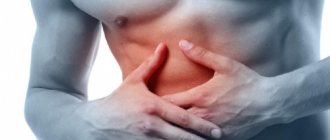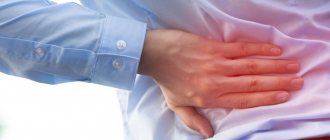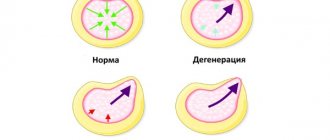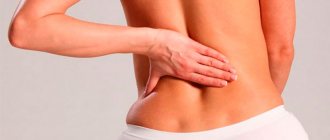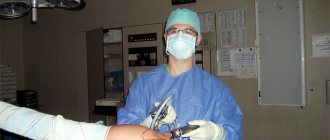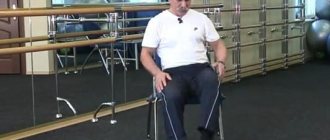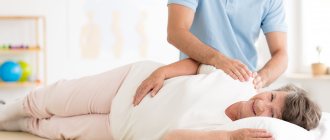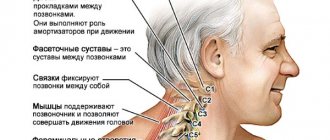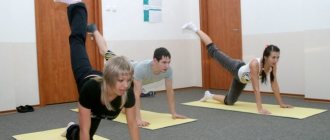Initial appointment with a NEUROLOGIST
ONLY 1800 rubles!
(more about prices below)
A neurologist diagnoses and treats spinal spondylosis. Spondylosis is a chronic condition that gradually progresses. It can lead to back pain, muscle stiffness, and low mobility of the cervical, thoracic, or lumbar spine. In the later stages of the disease in old age, one cannot count on a complete cure of spondylosis, but it is possible to use therapeutic methods to significantly slow down degenerative processes, improve the quality of life and increase the mobility of the spine.
Myths about the treatment of spondylosis
Some doctors explain spondylosis to patients as an independent disease, which is not entirely true. Strictly speaking, spondylosis is not a disease, but a protective reaction of the body to disc destruction. Bone outgrowths increase the area of support of the vertebrae, which partly compensates for the deterioration of disc function. Therefore, in the presence of spondylosis, treatment is required by its underlying cause, and not by the current condition. If your doctor suggests that you treat existing bone growths, you should be wary, since it is almost impossible to eliminate them, and a competent, good neurologist will have to explain this to you. However, with the help of therapy, the neurologist will be able to stop further growth and prevent greater deformation of the vertebral structures. If your attending physician suggests taking a course of manual therapy for spondylosis, this is another reason to think about whether you have a good neurologist. Spondylosis should not be confused with vertebral subluxation. Manual therapy really helps eliminate vertebral subluxation, compression of nerve roots and associated back pain. But it is impossible to restore metabolic processes in the intervertebral discs and stop compensatory mechanisms, including the formation of bone growths, with the help of manual therapy. Of course, osteopaths have the opportunity to relieve an attack of pain, but manual intervention alone cannot stop degenerative changes. This requires a comprehensive treatment course.
Causes of spondylosis
The disease occurs when a person's so-called longitudinal ligament, which connects the front of the cervical vertebrae, ruptures. As soon as this happens, the growth of bone tissue described above begins. There are a number of factors that contribute to damage or rupture of the longitudinal ligament and the subsequent formation of spondylosis. These include:
- Sports, domestic and professional injuries and overloads.
- Sitting for a long time.
- Osteochondrosis.
- Posture disorders.
- Flat feet.
- Aging of the body.
- Inflammation of the intervertebral joints (arthritis).
- Hypothermia.
- Flat feet.
- Aging of the body.
Prevention of spondylosis
Doctors at the Health Workshop advise to avoid neck problems:
- sleep on an orthopedic mattress;
- do swimming, yoga;
- walk more;
- keep your back and head straight when walking and at the computer;
When working at a computer, take a break every 2 hours and do exercises: circular movements with your shoulders, bending in different directions.
How to treat spinal spondylosis
In the arsenal of a neurologist-vertebrologist there are several ways to stop the negative consequences of spinal spondylosis.
Plasma therapy for the back. You can quickly relieve pain symptoms, improve nutrition and mineral metabolism in the vertebral structures with the help of spinal plasma therapy. Further, for complex treatment of the spine, the patient may be offered a course of physiotherapy. Her procedures are aimed at improving metabolic processes in the spine, enhancing nutrition and blood supply to the discs. But it is not possible to regress spondylosis 100%; it is important to concentrate all efforts on ensuring that these degenerative changes do not develop at an accelerated pace.
Acupuncture . An acupuncturist will be able to relieve inflammation from the roots and remove muscle spasms using reflex effects - acupuncture, acupressure. Massotherapy. Therapeutic massage is a medical procedure that is best left to specialists. Classic medical massage uses 4 techniques: stroking, rubbing, kneading, vibration. These movements alternate with each other during the massage course and improve blood supply, lymph flow and muscle defence. In this way, the doctor acts on subcutaneous fat and muscles, improving metabolism in the spinal area.
Exercise sets
Several gymnastic complexes that are used at any stage of the disease.
Relaxing
Can be performed even with acute pain. Perfect for both warm-up and cool-down. Releases the back and abdominal muscles.
Initially, the person lies on the floor face up, arms down along the body. Performed on six counts. Take a deep breath for two counts, and exhale slowly for four counts. Attention is paid to correct breathing and chest function. Duration 5-10 minutes.
Spine stretching
It has a good effect on reducing pain in lumbar spondylosis. It is carried out very carefully, only after a conversation with the attending physician.
Can be performed on a horizontal bar or wall bars. It is performed by hanging on the crossbar. The spine is stretched under the body's own weight. To increase the load, it is allowed to raise the knees to the stomach.
Spinal column stretch
Helps restore elasticity of the vertebrae. Stretches, relaxes the back muscles, reduces pain.
First exercise: first, the patient lies on the floor face up, arms extended along the body. You need to slowly bend your legs, trying to reach your chin. It takes 5-10 seconds.
Second exercise: initial state - on all fours, palms of hands shoulder-width apart. To perform the exercise, you need to bend over and touch the floor with your chest, then your chin. Hold the bend for 5-8 seconds, and then slowly return to the starting position. Repeat four to six times.
Third exercise: starting position – standing straight. Used to warm up the cervical vertebrae. The exercise is performed by slowly tilting the head forward - backward, right - left. Repeat eight or ten times.
Muscle training and improvement
These complexes allow you to strengthen your torso muscles. They promote a slim figure, improve posture, straighten curvatures, and prevent the formation of pathologies of spinal curvature. Used in a complex of therapeutic exercises after eliminating severe pain.
The first exercise of physical therapy: before training, a person lies on the ground face up, arms extended along the body. It is carried out by raising the head from the floor at an angle of forty-five degrees. The head is held in this position for 5 - 6 seconds.
Second exercise: initial state - lying on your back, arms closed under your head. The legs are alternately raised at an angle of forty-five degrees. Each time they are lifted, they are fixed.
Third exercise: the starting position of the second exercise is used. Rotational movements of the legs are carried out similar to the rotation of the pedals of a bicycle.
Fourth exercise: first, the patient takes the previous starting position. The outstretched legs rise up in front of you at an angle of forty-five degrees, then spread and cross, staying in the air for several seconds.
Fifth exercise: first, the patient takes a position similar to the previous one. Legs rise to the same angle. The exercise differs from the previous one in the direction of movement. In this case, the limbs alternately lower and rise.
Sixth exercise: starting position – standing on all fours. A diametric joint lift of one arm and the opposite leg is carried out parallel to the body. The limbs are fixed at the top point. Repeat with the next pair of arms and legs.
Seventh exercise: the patient sits on a stool. Feet are on the floor, knees bent, shoulder-width apart. The arms are lowered along the body, their fingers holding the seat. When carrying out the task, the hands press the torso into the stool, the legs try to lift it off the floor along with the stool.
In all options, fixation of the limbs is 5-6 seconds.
For sacral disease
It is advisable not to perform a gymnastic complex for spondylosis of the lumbosacral spine while standing. It is very important to relieve the vertebrae as much as possible. It is advisable to perform all exercises lying down or sitting.
An approximate list of training for spondyloarthrosis of the lumbosacral spine.
First exercise: the patient lies on the floor face up, arms extended along the body. Alternate bends are made to the left and right sides. Deviations from the central axis of the body are performed until a feeling of tension in the torso muscles is felt. Repeated 5 times.
Second exercise: the initial pose is similar to the first task. We pump up the press, stretch the vertebra. To implement this element of charging, it is necessary to slowly raise the body to the greatest height and fix the position of the body for fifteen seconds. After this time, take the starting position. Repeated up to ten times.
Third exercise: moving on all fours around the room with your back arched and your hips raised every five steps. The number of repetitions is not limited until slight fatigue occurs (severe pain should not be allowed; if severe pain occurs, you need to stop).
Fourth exercise: the starting position is similar to the first task. It is necessary to slowly pull your arms and legs up. The lifting height is determined by physical capabilities. At the top point, fix the body for thirty or forty seconds, then return to the original state. Repeats up to seven times.
Fifth exercise: the patient sits on a chair. Your back is pressed against his back, your hands firmly hold the seat on both sides. Performed by alternately lifting the legs. At the highest point the limbs are fixed. The duration of fixation is 60 seconds, then the legs return to the starting position. Performed separately with each leg, then with both legs together. The complex is performed at least three times.
Exercises for lumbar spondyloarthrosis are carried out with a gradual load. First, the easiest ones are performed with the least load on the spinal column. They move on to more complex elements after achieving maximum success in performing easier therapeutic exercises.
Spondylosis and surgery
In the vast majority of cases, this condition does not require surgical treatment. This disease is an indication for surgery only in exceptional cases, when there is a threat of compression of the spinal cord and paralysis.
Author: Shogenov Ramish Kurbanovich
Neurologist with 10 years of experience
| Service | Price | Price | Promotion Price |
| Appointment with a therapist | primary 1800 rub. | repeat 1500 rub. | |
| Neurologist appointment | primary 1800 rub. | repeat 1500 rub. | free after MRI of the spine |
| Orthopedist appointment | primary 1800 rub. | repeat 1500 rub. | free after MRI of the joint |
| Consultation with an acupuncturist | primary 1800 rub. | repeat 1500 rub. | free after MRI of the spine |
| Vertebrologist consultation | primary 2000 rub. | repeat 1800 rub. | |
| Consultation with a chiropractor/osteopath | primary 2500 rub. |
| Service | Price according to Price | Discount | Discount |
| Plasma therapy of the spine or joint | 1 session 4000 rub. free doctor's appointment | 3 sessions 10,500 rub. free doctor's appointment | 5 sessions 17,500 rub. free doctor's appointment |
| Classic acupuncture session | 1500 rub. | ||
| Complex acupuncture session | 2000 rub. | ||
| Manual osteopathy session | 2500 rub. | ||
| Manual therapy session | 2500 rub. | ||
| Autohemotherapy | 550 rub. | 5 sessions 2500 rub. | 10 sessions 5000 rub. |
| Novocaine therapeutic blockade | 1500 rub. | ||
| Therapeutic paravertebral blockade | 1500 rub. | ||
| The blockade is therapeutic and medicinal, complex (use of several drugs) | 2000 rub. | ||
| Therapeutic intra-articular blockade with diprospan | 2500 rub. | ||
| Joint puncture with removal of synovial fluid | 2500 rub. | ||
| Intra-articular injection of hyaluronic acid (without the cost of the drug) | 2000 rub. | ||
| Novocaine therapeutic blockade | 1500 rub. | ||
| Therapeutic paravertebral blockade | 1500 rub. | ||
| Therapeutic intra-articular blockade with diprospan | 2500 rub. | ||
| Joint puncture with removal of synovial fluid | 2500 rub. | ||
| Pharmacocupuncture session (drug at the discretion of the doctor) | 2500 rub. | ||
| Pharmacocupuncture session (without the cost of the drug) | 2100 rub. | ||
| Electrophoresis session (without the cost of the drug) | 400 rub. | ||
| Phonophoresis session / Ultrasound therapy procedure (UT) (without the cost of the drug) | 450 rub. | ||
| Magnetic therapy session | 350 rub. | ||
| SMT therapy session (Sinusoidal modulated currents) | 450 rub. | ||
| Vitamin therapy (10 injections) | 4000 rub. free doctor's appointment | 3000 rub. free doctor's appointment | 3000 rub. free doctor's appointment |
| Injections (Vitamins B12) | 800 rub. | 800 rub. | 800 rub. |
| Intravenous administration of drugs | 450 rub. | 5 sessions 2140 rub. | 10 sessions 4050 rub. |
| Intravenous drip administration of drugs (without drugs, 1 bottle) | 800 rub. | 5 sessions 3375 rub. | 10 sessions 6750 rub. |
| Intravenous drip administration of medications (with existing clinic medications, 1 bottle) | 950 rub. | 5 sessions 4050 rub. | 10 sessions 8100 rub. |
| Intravenous drip administration of drugs (without drugs, 2 bottles) | 950 rub. | 5 sessions 4050 rub. | 10 sessions 8100 rub. |
| Intravenous drip administration of medications (with existing clinic medications, 2 bottles) | 1100 rub. | 5 sessions 4700 rub. | 10 sessions 9400 rub. |
| Subcutaneous/intradermal administration of drugs | 250 rub. | 5 sessions 1180 rub. | 10 sessions 2250 rub. |
| Intramuscular administration of drugs | 300 rub. | 5 sessions 1430 rub. | 10 sessions 2700 rub. |
Reviews
01/15/2018 I am very grateful to all the employees for their attentive attitude towards people and the qualifications of a neurologist.
Povozhilova
05/16/2017 This is not the first time I have contacted a neurologist, I am very pleased with the service.
Thank you very much for your work. I will come to you again. Meshkova
12/26/2017 Admitted with pain in the thoracic spine.
Diagnosis: spondyloarthrosis. Three plasma therapy procedures were performed without hormones and analgesics. The result is good. The pain stopped. Grateful to doctor Shogenov R.K. Patient
Read all reviews
Useful tips
At all stages of the disease, before starting gymnastics, you should consult a doctor. The specialist will determine the degree of illness, the patient’s ability to perform exercises, help select an individual program, warn against common mistakes, and advise how to perform the exercises technically correctly.
Rules for self-study:
- do not exercise during the period of exacerbation of the disease;
- stop exercising if pain appears or increases;
- the loads should initially be insignificant and gradually increase;
- you need to train daily;
- the duration of training should be gradually increased from ten to forty-five minutes;
- make the most of the morning time for studying;
- When conducting classes twice a day, distribute the load: in the morning to increase mobility, in the evening for a calming nature.
After achieving positive results, the load can be gradually increased. New, more complex elements are introduced gradually, one at a time, maximum two per workout. The final training complex (after gradually increasing the number of exercises) can consist of eight to twelve exercises. Less will be ineffective, more will be difficult. Each exercise is repeated 3 to 5 times in one approach (more - only with the permission of the doctor). Charging begins with relaxing exercises and gradually moves on to strengthening ones, combined with stretching. You can complete the classes by hanging on the crossbar or wall bars.
In therapeutic exercises there is no need to use sharp swings. Smooth, sedate movements promote recovery, sudden ones can cause harm. The goal is to strengthen the muscles so they can hold the bones.
A healthy lifestyle is the path to success. Active recreation, walking in the fresh air, and diet are the main components of restoring and maintaining health. Therapeutic exercises will strengthen the body. Optimism and self-confidence will help cope with the disease.
